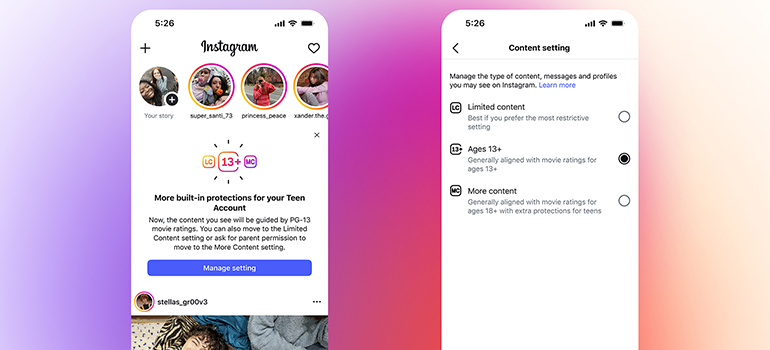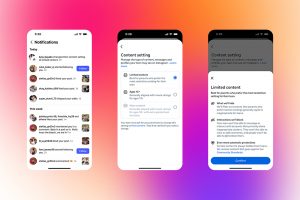 The minimum age to open an Instagram account has always been 13. While some parents still feel this is too young, many have eventually relented and let their teens sign up anyway. Kids from aged 13-17 were always classified into Teen Accounts with built-in safety settings. But this hasn’t been enough.
The minimum age to open an Instagram account has always been 13. While some parents still feel this is too young, many have eventually relented and let their teens sign up anyway. Kids from aged 13-17 were always classified into Teen Accounts with built-in safety settings. But this hasn’t been enough.
The impact social media has on the mental health of children has been well-documented, and it’s no secret that exposure to social media in and of itself is damaging for the new generation. According to Mental Health Research Canada, extended screen time and negative online experiences are linked to higher rates of anxiety, depression, psychological distress, and suicidal ideation in youths aged 16-24.
Of course, the simplest solution is to not let your kids get social media accounts at all. But that’s easier said than done. Even if parents ban their kids, they’ll still see content from their friends’ phones and may find ways to circumvent your rules. This isn’t an excuse to give in, of course. But if you feel you have enough trust in your kids and you’re willing to keep an open dialogue with them, Meta has made major changes to the way Teen Accounts are set up and used on Instagram. Many new restrictions are designed to make the browsing and interacting experience more age appropriate.
The guide for the new system is the well-known PG-13 movie content rating. Basically, if something wouldn’t be seen in a PG-13 movie, teens will not be able to see it on Instagram either. Here’s what to know about the changes to Instagram Teen Accounts.
Age Prediction Technology in Set-up
 First, kids who sign up noting their age as being under 18 will be automatically placed under these new settings. These cannot be changed without a parent’s permission. An even stricter setting involves age prediction technology. If kids try to input an age older than their real one to circumvent the rules, Instagram’s AI algorithms will determine if they aren’t the age they claim to be by analyzing things like how they interact with content on the platform. If it’s determined that this person likely isn’t the age they claim to be, they’ll be moved to the teen account. Further, teens who already have an account will have to verify their identity with a video selfie or an ID check if they try to change their birthyear.
First, kids who sign up noting their age as being under 18 will be automatically placed under these new settings. These cannot be changed without a parent’s permission. An even stricter setting involves age prediction technology. If kids try to input an age older than their real one to circumvent the rules, Instagram’s AI algorithms will determine if they aren’t the age they claim to be by analyzing things like how they interact with content on the platform. If it’s determined that this person likely isn’t the age they claim to be, they’ll be moved to the teen account. Further, teens who already have an account will have to verify their identity with a video selfie or an ID check if they try to change their birthyear.
Restricted Content
Content that is sexually suggestive, contains graphic or disturbing images, or promotes alcohol and tobacco sales, will not be visible to kids. While some suggestive content or content with strong language can slip through the cracks, just as some PG-13 movies have suggestive jokes or swear words, this may happen from time to time. However, Meta says it will be working to make such instances “as rare as possible.”
Hiding Inappropriate Posts
Teens won’t be able to see inappropriate posts. These will not be recommended either, nor will kids find these accounts in search. This includes posts with strong language, risky stunts or potentially harmful behaviour, and ones with marijuana paraphernalia. Teens might know the account names of people they want to follow, but they will not be able to do so if the person or company regularly shares age-inappropriate content, or if the name or bio suggests that it does. This means not being able to send DMs to them either, nor see their comments under posts. The account holders will not be able to follow teens, message them, or posts comment on their content.
Blocking Mature Search Terms
 There’s an expanded list of search terms that will be blocked for teens. Along with terms about sensitive topics like suicide, self-harm, and eating disorders, teens will not be able to search for content about alcohol or gore. Meta is working on filtering these results out even if teens accidentally (or intentionally) misspell them. If such content is sent to them, they won’t be able to see it nor open DMs relating to these subjects.
There’s an expanded list of search terms that will be blocked for teens. Along with terms about sensitive topics like suicide, self-harm, and eating disorders, teens will not be able to search for content about alcohol or gore. Meta is working on filtering these results out even if teens accidentally (or intentionally) misspell them. If such content is sent to them, they won’t be able to see it nor open DMs relating to these subjects.
Even More Limited Content
 These restrictions should help filter out a lot of the harmful and inappropriate content, but Meta has a secondary level of security for parents who want to give their kids the freedom to join but still have concerns. The Limited Content setting prevents teens from being able to see, leave, or receive comments under posts at all. In 2026, the feature will be updated to restrict AI conversations teens can have within the app as well.
These restrictions should help filter out a lot of the harmful and inappropriate content, but Meta has a secondary level of security for parents who want to give their kids the freedom to join but still have concerns. The Limited Content setting prevents teens from being able to see, leave, or receive comments under posts at all. In 2026, the feature will be updated to restrict AI conversations teens can have within the app as well.
Parent Flagging

Along with seeking feedback from parents as this new Teen Account setup rolls out, Meta is also looking at a way that parents can flag posts they happen to see that they think should be hidden from teens. If the post isn’t already on the list, it will be evaluated and a decision sent to the parent to let them know the outcome and why.
Should Your Teen Have Instagram?
Keeping a teen away from Instagram in the early teenage years is likely easier. Kids of that age are more interested in apps like Discord, SnapChat, and TikTok, though these apps raise their own selection of concerns, too. But once they get to age 16, kids will be begging to get online to communicate with their friends.
It’s important for parents to sit down with their kids before exposing them to the world of social media. Check in constantly, ensure you have access to their devices and accounts, and be aware of the type of content they consume. Even then, it’s tough to know everything. Snapchat has disappearing messages. Kids create “Finsta” accounts on Instagram (a fake Instagram account that’s virtually impossible to find without knowing the username). And there’s no real way of knowing what they are viewing on TikTok.
Proceed With Caution
Arguably, what we really need is a complete social media reset, especially when it comes to kids. For now, these Instagram Teen Account restrictions are a step in the right direction. But it’s also one that experts like Richard Lachman, a professor at the RTA School of Media at Toronto Metropolitan University, tells CBC could have, and should have, been taken a long time ago. Keyword filtering, for example, he says, does not exactly require advanced work to accomplish. What’s more, while video selfie identification for teens who already have accounts and age prediction technology are positives, it’s unclear how well these features will actually work.
Most important, technology analyst Carmi Levy tells CBC that parents should not feel like these new restrictions drastically change the way kids will interact on social media platforms like Instagram. It won’t, and it isn’t an open door to let kids in if you still have serious reservations. Levy admits that restricting kids entirely isn’t the answer either, because they’ll just go behind your back anyway. “Have those conversations [about the risks of social media],” he advises, “so they know they can come to you in a trusting environment, no judgement.”
If you haven’t yet seen these new Teen Account settings, they will continue to roll out through to the end of the year, with Canada being among the first four regions along with the U.S., U.K., and Australia.
-30-



